400238: Policy Analysis of National Women's Health Policy 2010 Report
VerifiedAdded on 2022/08/16
|13
|4083
|25
Report
AI Summary
This report provides an in-depth analysis of the National Women's Health Policy 2010, focusing on its development, objectives, and impact on the health outcomes of women in Australia. The analysis begins with an introduction to the policy's context, highlighting the importance of addressing health disparities and inequalities. The report then delves into the policy's history, principles, and key areas of focus, including ageing, reproductive health, mental health, and chronic disease prevention. The Australian Policy Cycle is used to frame the analysis, examining the policy's coordination, decision-making, implementation, and evaluation. The report also reviews the evolution of women's health policies in Australia, including the first National Women's Health Policy of 1989, and the factors that influenced the development of the 2010 policy. The analysis highlights criticisms and gaps in previous policies, such as the exclusion of certain groups, and how the 2010 policy aimed to address these issues. The report concludes by discussing the policy's significance in the Australian health care system and its potential to improve the well-being of women across diverse backgrounds. The report emphasizes the importance of evidence-based practices, health equity, and gender equality in achieving the policy's objectives.

Running head: POLICY ANALYSIS
Analysis of National Women’s Health Policy 2010
Name of the Student
Name of the University
Author Note
Analysis of National Women’s Health Policy 2010
Name of the Student
Name of the University
Author Note
Paraphrase This Document
Need a fresh take? Get an instant paraphrase of this document with our AI Paraphraser
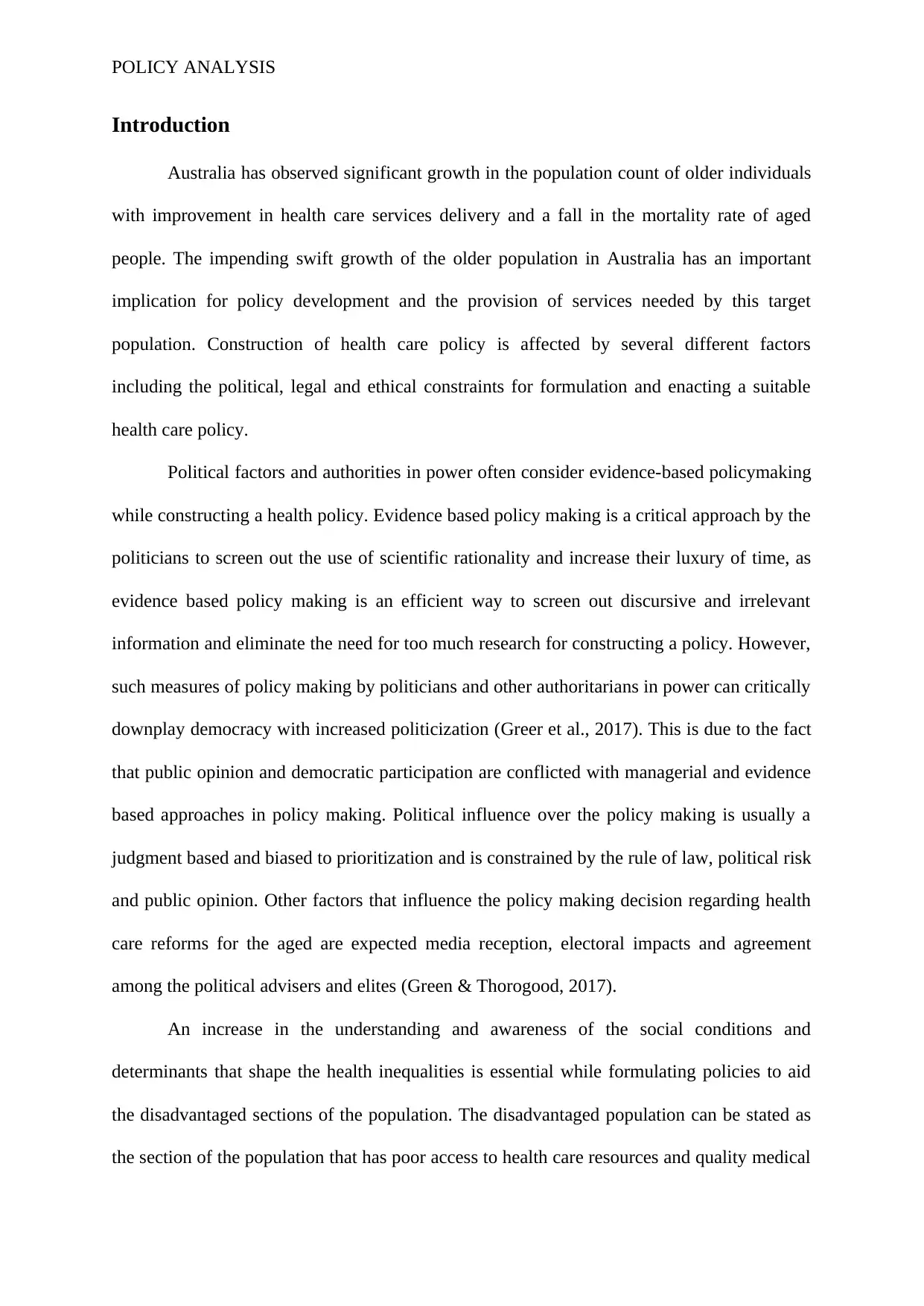
POLICY ANALYSIS
Introduction
Australia has observed significant growth in the population count of older individuals
with improvement in health care services delivery and a fall in the mortality rate of aged
people. The impending swift growth of the older population in Australia has an important
implication for policy development and the provision of services needed by this target
population. Construction of health care policy is affected by several different factors
including the political, legal and ethical constraints for formulation and enacting a suitable
health care policy.
Political factors and authorities in power often consider evidence-based policymaking
while constructing a health policy. Evidence based policy making is a critical approach by the
politicians to screen out the use of scientific rationality and increase their luxury of time, as
evidence based policy making is an efficient way to screen out discursive and irrelevant
information and eliminate the need for too much research for constructing a policy. However,
such measures of policy making by politicians and other authoritarians in power can critically
downplay democracy with increased politicization (Greer et al., 2017). This is due to the fact
that public opinion and democratic participation are conflicted with managerial and evidence
based approaches in policy making. Political influence over the policy making is usually a
judgment based and biased to prioritization and is constrained by the rule of law, political risk
and public opinion. Other factors that influence the policy making decision regarding health
care reforms for the aged are expected media reception, electoral impacts and agreement
among the political advisers and elites (Green & Thorogood, 2017).
An increase in the understanding and awareness of the social conditions and
determinants that shape the health inequalities is essential while formulating policies to aid
the disadvantaged sections of the population. The disadvantaged population can be stated as
the section of the population that has poor access to health care resources and quality medical
Introduction
Australia has observed significant growth in the population count of older individuals
with improvement in health care services delivery and a fall in the mortality rate of aged
people. The impending swift growth of the older population in Australia has an important
implication for policy development and the provision of services needed by this target
population. Construction of health care policy is affected by several different factors
including the political, legal and ethical constraints for formulation and enacting a suitable
health care policy.
Political factors and authorities in power often consider evidence-based policymaking
while constructing a health policy. Evidence based policy making is a critical approach by the
politicians to screen out the use of scientific rationality and increase their luxury of time, as
evidence based policy making is an efficient way to screen out discursive and irrelevant
information and eliminate the need for too much research for constructing a policy. However,
such measures of policy making by politicians and other authoritarians in power can critically
downplay democracy with increased politicization (Greer et al., 2017). This is due to the fact
that public opinion and democratic participation are conflicted with managerial and evidence
based approaches in policy making. Political influence over the policy making is usually a
judgment based and biased to prioritization and is constrained by the rule of law, political risk
and public opinion. Other factors that influence the policy making decision regarding health
care reforms for the aged are expected media reception, electoral impacts and agreement
among the political advisers and elites (Green & Thorogood, 2017).
An increase in the understanding and awareness of the social conditions and
determinants that shape the health inequalities is essential while formulating policies to aid
the disadvantaged sections of the population. The disadvantaged population can be stated as
the section of the population that has poor access to health care resources and quality medical

POLICY ANALYSIS
care, increasing the risk of negative health outcome in the population (Braveman et al., 2018).
The formulation of health, social and aged care policies, by the government and relevant
authorities, can play a pervasive, powerful and fundamental role in addressing the
disproportionately disadvantaged sections of the population while widening social
inequalities and increasing evidence based practices to understand the social condition and
their health impact that the disadvantaged group is affected. The primary objective of such
health related policies should be to remove health disparities and inequalities by emphasizing
on the health needs of the disadvantaged groups and addressing the social determinants of
health including political and economical that are influencing the health condition of the
targeted groups (Kriznik et al., 2018).
The chosen policy to be analysed in this paper is the National Women’s Health Policy
2010, which is coordinated and formulated by the Department of Health and Ageing,
Government of Australia. The inputs taken into consideration while constructing the policy
for the target population of women in Australia are collected from the written submissions,
public consultations and points highlighted in the National Women’s Health Policy
Roundtable to address the health issues the women are facing and plan steps to improve the
overall well-being of the target population. The National Women’s Health Policy 2010 is
aimed to be highly significant with the improvement of the overall health system of Australia
with the objectives of bringing gender equality, focusing on preventive measures, ensuring
health equity between women and determining a strong and evidence based approach
(Dobson, Byles & Brown, 2016). This policy has high significance as it addresses the critical
section of the population, such as women from Aboriginal and Torres Strait Islander
population, who are at high risk of poor health with increased gap and barriers in accessing
adequate health care services. Moreover, the policy aims at aiding the socio-economically
care, increasing the risk of negative health outcome in the population (Braveman et al., 2018).
The formulation of health, social and aged care policies, by the government and relevant
authorities, can play a pervasive, powerful and fundamental role in addressing the
disproportionately disadvantaged sections of the population while widening social
inequalities and increasing evidence based practices to understand the social condition and
their health impact that the disadvantaged group is affected. The primary objective of such
health related policies should be to remove health disparities and inequalities by emphasizing
on the health needs of the disadvantaged groups and addressing the social determinants of
health including political and economical that are influencing the health condition of the
targeted groups (Kriznik et al., 2018).
The chosen policy to be analysed in this paper is the National Women’s Health Policy
2010, which is coordinated and formulated by the Department of Health and Ageing,
Government of Australia. The inputs taken into consideration while constructing the policy
for the target population of women in Australia are collected from the written submissions,
public consultations and points highlighted in the National Women’s Health Policy
Roundtable to address the health issues the women are facing and plan steps to improve the
overall well-being of the target population. The National Women’s Health Policy 2010 is
aimed to be highly significant with the improvement of the overall health system of Australia
with the objectives of bringing gender equality, focusing on preventive measures, ensuring
health equity between women and determining a strong and evidence based approach
(Dobson, Byles & Brown, 2016). This policy has high significance as it addresses the critical
section of the population, such as women from Aboriginal and Torres Strait Islander
population, who are at high risk of poor health with increased gap and barriers in accessing
adequate health care services. Moreover, the policy aims at aiding the socio-economically
⊘ This is a preview!⊘
Do you want full access?
Subscribe today to unlock all pages.

Trusted by 1+ million students worldwide
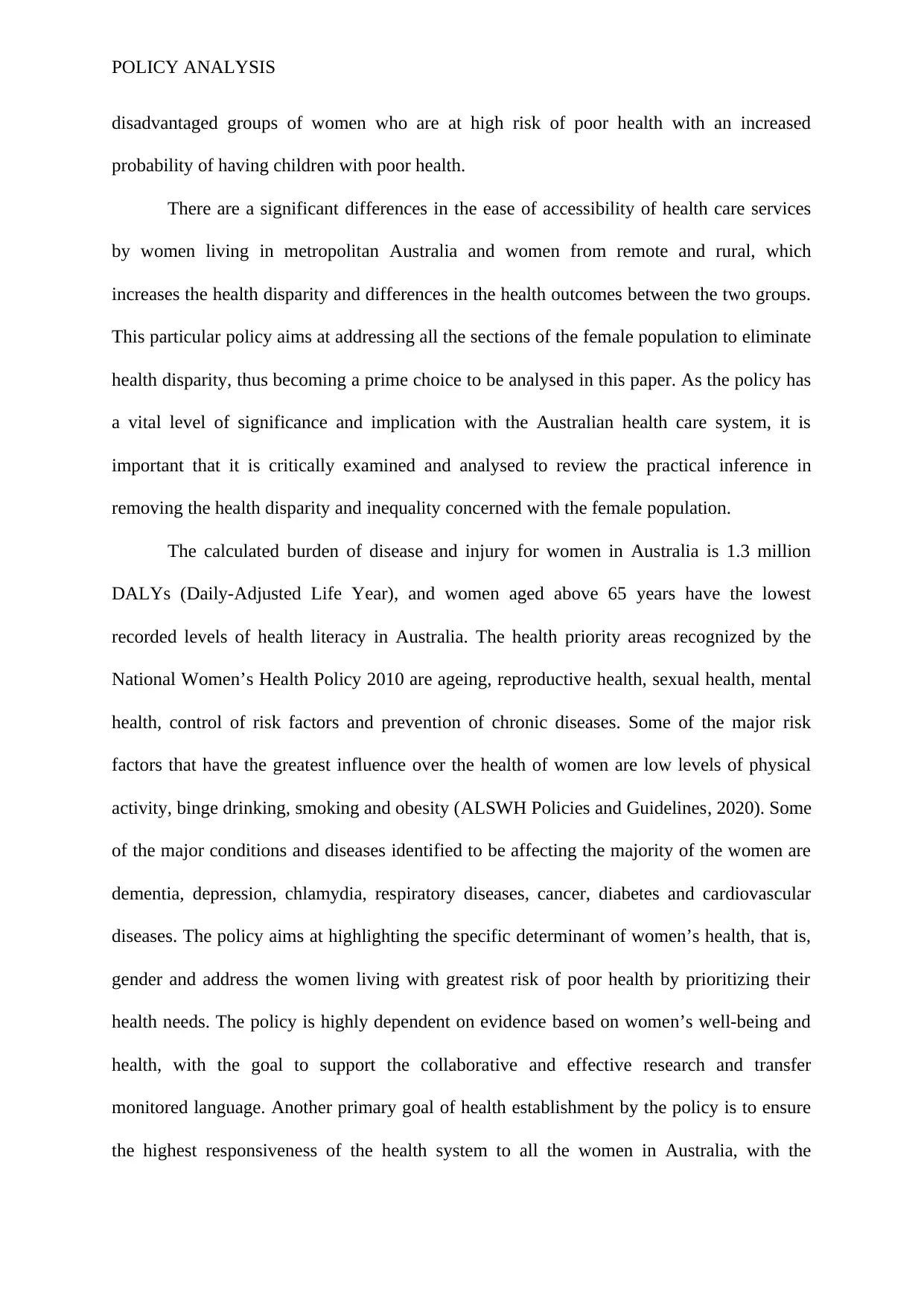
POLICY ANALYSIS
disadvantaged groups of women who are at high risk of poor health with an increased
probability of having children with poor health.
There are a significant differences in the ease of accessibility of health care services
by women living in metropolitan Australia and women from remote and rural, which
increases the health disparity and differences in the health outcomes between the two groups.
This particular policy aims at addressing all the sections of the female population to eliminate
health disparity, thus becoming a prime choice to be analysed in this paper. As the policy has
a vital level of significance and implication with the Australian health care system, it is
important that it is critically examined and analysed to review the practical inference in
removing the health disparity and inequality concerned with the female population.
The calculated burden of disease and injury for women in Australia is 1.3 million
DALYs (Daily-Adjusted Life Year), and women aged above 65 years have the lowest
recorded levels of health literacy in Australia. The health priority areas recognized by the
National Women’s Health Policy 2010 are ageing, reproductive health, sexual health, mental
health, control of risk factors and prevention of chronic diseases. Some of the major risk
factors that have the greatest influence over the health of women are low levels of physical
activity, binge drinking, smoking and obesity (ALSWH Policies and Guidelines, 2020). Some
of the major conditions and diseases identified to be affecting the majority of the women are
dementia, depression, chlamydia, respiratory diseases, cancer, diabetes and cardiovascular
diseases. The policy aims at highlighting the specific determinant of women’s health, that is,
gender and address the women living with greatest risk of poor health by prioritizing their
health needs. The policy is highly dependent on evidence based on women’s well-being and
health, with the goal to support the collaborative and effective research and transfer
monitored language. Another primary goal of health establishment by the policy is to ensure
the highest responsiveness of the health system to all the women in Australia, with the
disadvantaged groups of women who are at high risk of poor health with an increased
probability of having children with poor health.
There are a significant differences in the ease of accessibility of health care services
by women living in metropolitan Australia and women from remote and rural, which
increases the health disparity and differences in the health outcomes between the two groups.
This particular policy aims at addressing all the sections of the female population to eliminate
health disparity, thus becoming a prime choice to be analysed in this paper. As the policy has
a vital level of significance and implication with the Australian health care system, it is
important that it is critically examined and analysed to review the practical inference in
removing the health disparity and inequality concerned with the female population.
The calculated burden of disease and injury for women in Australia is 1.3 million
DALYs (Daily-Adjusted Life Year), and women aged above 65 years have the lowest
recorded levels of health literacy in Australia. The health priority areas recognized by the
National Women’s Health Policy 2010 are ageing, reproductive health, sexual health, mental
health, control of risk factors and prevention of chronic diseases. Some of the major risk
factors that have the greatest influence over the health of women are low levels of physical
activity, binge drinking, smoking and obesity (ALSWH Policies and Guidelines, 2020). Some
of the major conditions and diseases identified to be affecting the majority of the women are
dementia, depression, chlamydia, respiratory diseases, cancer, diabetes and cardiovascular
diseases. The policy aims at highlighting the specific determinant of women’s health, that is,
gender and address the women living with greatest risk of poor health by prioritizing their
health needs. The policy is highly dependent on evidence based on women’s well-being and
health, with the goal to support the collaborative and effective research and transfer
monitored language. Another primary goal of health establishment by the policy is to ensure
the highest responsiveness of the health system to all the women in Australia, with the
Paraphrase This Document
Need a fresh take? Get an instant paraphrase of this document with our AI Paraphraser

POLICY ANALYSIS
greatest priority given to health promotion and illness prevention. By providing guidelines to
revise the current government actions, the policy aims to broader the health reforms and
address health inequalities along with social determinants affecting the health of the female
population in the country.
Policy Discussion
Policies are considered to be the primary instrument of government to ensure proper
governance of their undertaking province. The Australian policy cycle, as stated by Freeman
(2012), is a centralised administrative and academic policy documentation analysis
framework, which the universities can use for comprehensive policy evaluation and review
processes. The research conducted by Freeman (2012) addresses three concerns, which are
defining policy review with meta-policy. Policy implementation review and resource,
systems and approaches used for reviewing policies. The National Women’s Health Policy
will be reviewed with the help of point factors mentioned in the Australian Policy Cycle. The
point factors included in the Australian Policy Cycle are coordination, decision,
implementation, evaluation, identify issues, policy analysis, policy instruments, and
consultation (Althaus, Bridgman & Davis, 2017). While reviewing the second National
Women’s Health Policy, the history including the enactment of first National Women’s
Health Policy 1989 and the relevant incidences and happening in the intermediate two
decades, will be taken into consideration to articulate the policy process and reviewing its
development.
The first National Women’s Health Policy was developed in the year 1989, where
more than one million women contributed to policy development. The issues identified that
led to the development of a policy for women’s health were violence against women, sex role
stereotyping and its health effect on women, emotional and mental health, health needs of the
women acting as carers, ageing, sexuality and reproductive health of women (Seymour,
greatest priority given to health promotion and illness prevention. By providing guidelines to
revise the current government actions, the policy aims to broader the health reforms and
address health inequalities along with social determinants affecting the health of the female
population in the country.
Policy Discussion
Policies are considered to be the primary instrument of government to ensure proper
governance of their undertaking province. The Australian policy cycle, as stated by Freeman
(2012), is a centralised administrative and academic policy documentation analysis
framework, which the universities can use for comprehensive policy evaluation and review
processes. The research conducted by Freeman (2012) addresses three concerns, which are
defining policy review with meta-policy. Policy implementation review and resource,
systems and approaches used for reviewing policies. The National Women’s Health Policy
will be reviewed with the help of point factors mentioned in the Australian Policy Cycle. The
point factors included in the Australian Policy Cycle are coordination, decision,
implementation, evaluation, identify issues, policy analysis, policy instruments, and
consultation (Althaus, Bridgman & Davis, 2017). While reviewing the second National
Women’s Health Policy, the history including the enactment of first National Women’s
Health Policy 1989 and the relevant incidences and happening in the intermediate two
decades, will be taken into consideration to articulate the policy process and reviewing its
development.
The first National Women’s Health Policy was developed in the year 1989, where
more than one million women contributed to policy development. The issues identified that
led to the development of a policy for women’s health were violence against women, sex role
stereotyping and its health effect on women, emotional and mental health, health needs of the
women acting as carers, ageing, sexuality and reproductive health of women (Seymour,
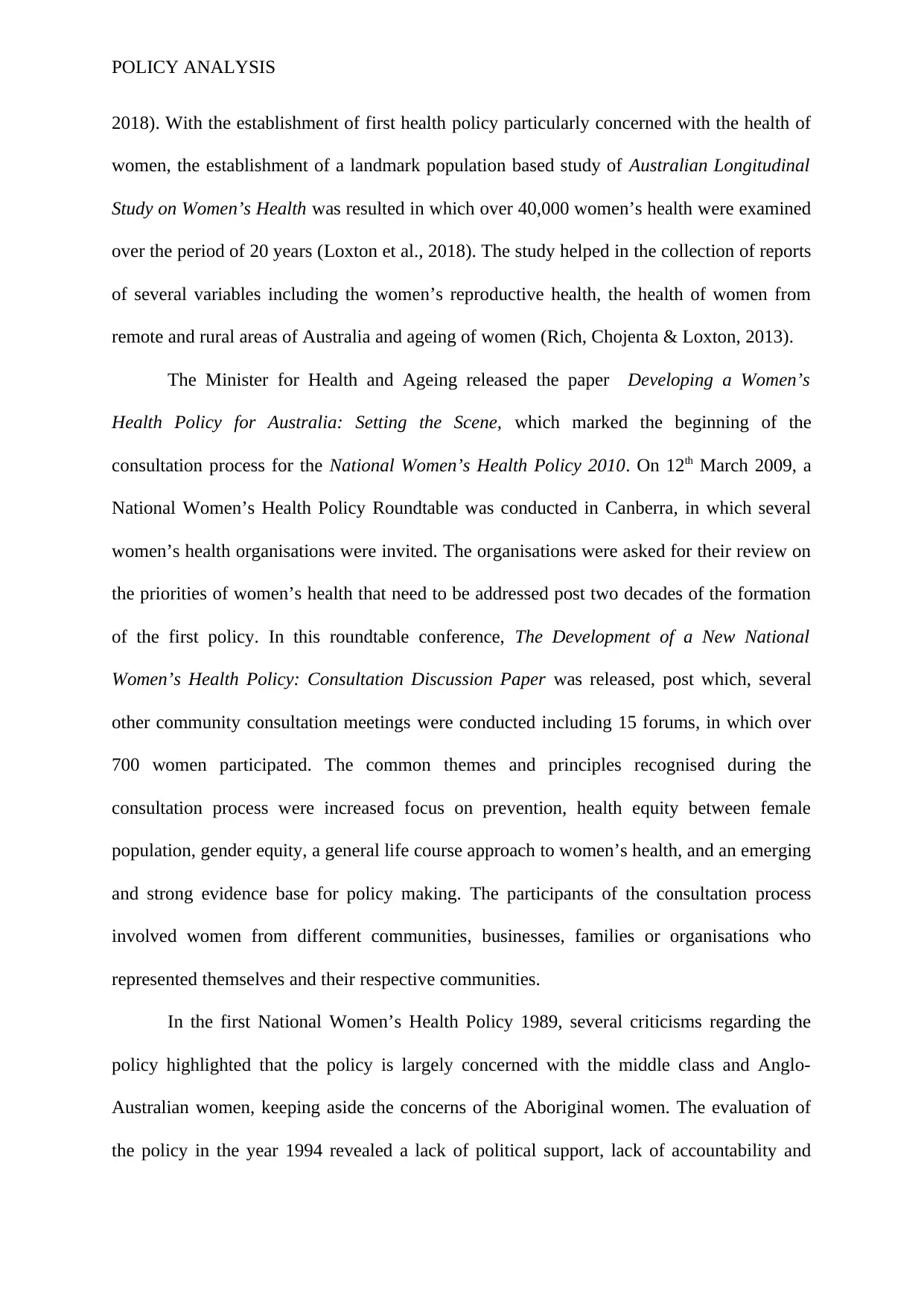
POLICY ANALYSIS
2018). With the establishment of first health policy particularly concerned with the health of
women, the establishment of a landmark population based study of Australian Longitudinal
Study on Women’s Health was resulted in which over 40,000 women’s health were examined
over the period of 20 years (Loxton et al., 2018). The study helped in the collection of reports
of several variables including the women’s reproductive health, the health of women from
remote and rural areas of Australia and ageing of women (Rich, Chojenta & Loxton, 2013).
The Minister for Health and Ageing released the paper Developing a Women’s
Health Policy for Australia: Setting the Scene, which marked the beginning of the
consultation process for the National Women’s Health Policy 2010. On 12th March 2009, a
National Women’s Health Policy Roundtable was conducted in Canberra, in which several
women’s health organisations were invited. The organisations were asked for their review on
the priorities of women’s health that need to be addressed post two decades of the formation
of the first policy. In this roundtable conference, The Development of a New National
Women’s Health Policy: Consultation Discussion Paper was released, post which, several
other community consultation meetings were conducted including 15 forums, in which over
700 women participated. The common themes and principles recognised during the
consultation process were increased focus on prevention, health equity between female
population, gender equity, a general life course approach to women’s health, and an emerging
and strong evidence base for policy making. The participants of the consultation process
involved women from different communities, businesses, families or organisations who
represented themselves and their respective communities.
In the first National Women’s Health Policy 1989, several criticisms regarding the
policy highlighted that the policy is largely concerned with the middle class and Anglo-
Australian women, keeping aside the concerns of the Aboriginal women. The evaluation of
the policy in the year 1994 revealed a lack of political support, lack of accountability and
2018). With the establishment of first health policy particularly concerned with the health of
women, the establishment of a landmark population based study of Australian Longitudinal
Study on Women’s Health was resulted in which over 40,000 women’s health were examined
over the period of 20 years (Loxton et al., 2018). The study helped in the collection of reports
of several variables including the women’s reproductive health, the health of women from
remote and rural areas of Australia and ageing of women (Rich, Chojenta & Loxton, 2013).
The Minister for Health and Ageing released the paper Developing a Women’s
Health Policy for Australia: Setting the Scene, which marked the beginning of the
consultation process for the National Women’s Health Policy 2010. On 12th March 2009, a
National Women’s Health Policy Roundtable was conducted in Canberra, in which several
women’s health organisations were invited. The organisations were asked for their review on
the priorities of women’s health that need to be addressed post two decades of the formation
of the first policy. In this roundtable conference, The Development of a New National
Women’s Health Policy: Consultation Discussion Paper was released, post which, several
other community consultation meetings were conducted including 15 forums, in which over
700 women participated. The common themes and principles recognised during the
consultation process were increased focus on prevention, health equity between female
population, gender equity, a general life course approach to women’s health, and an emerging
and strong evidence base for policy making. The participants of the consultation process
involved women from different communities, businesses, families or organisations who
represented themselves and their respective communities.
In the first National Women’s Health Policy 1989, several criticisms regarding the
policy highlighted that the policy is largely concerned with the middle class and Anglo-
Australian women, keeping aside the concerns of the Aboriginal women. The evaluation of
the policy in the year 1994 revealed a lack of political support, lack of accountability and
⊘ This is a preview!⊘
Do you want full access?
Subscribe today to unlock all pages.

Trusted by 1+ million students worldwide
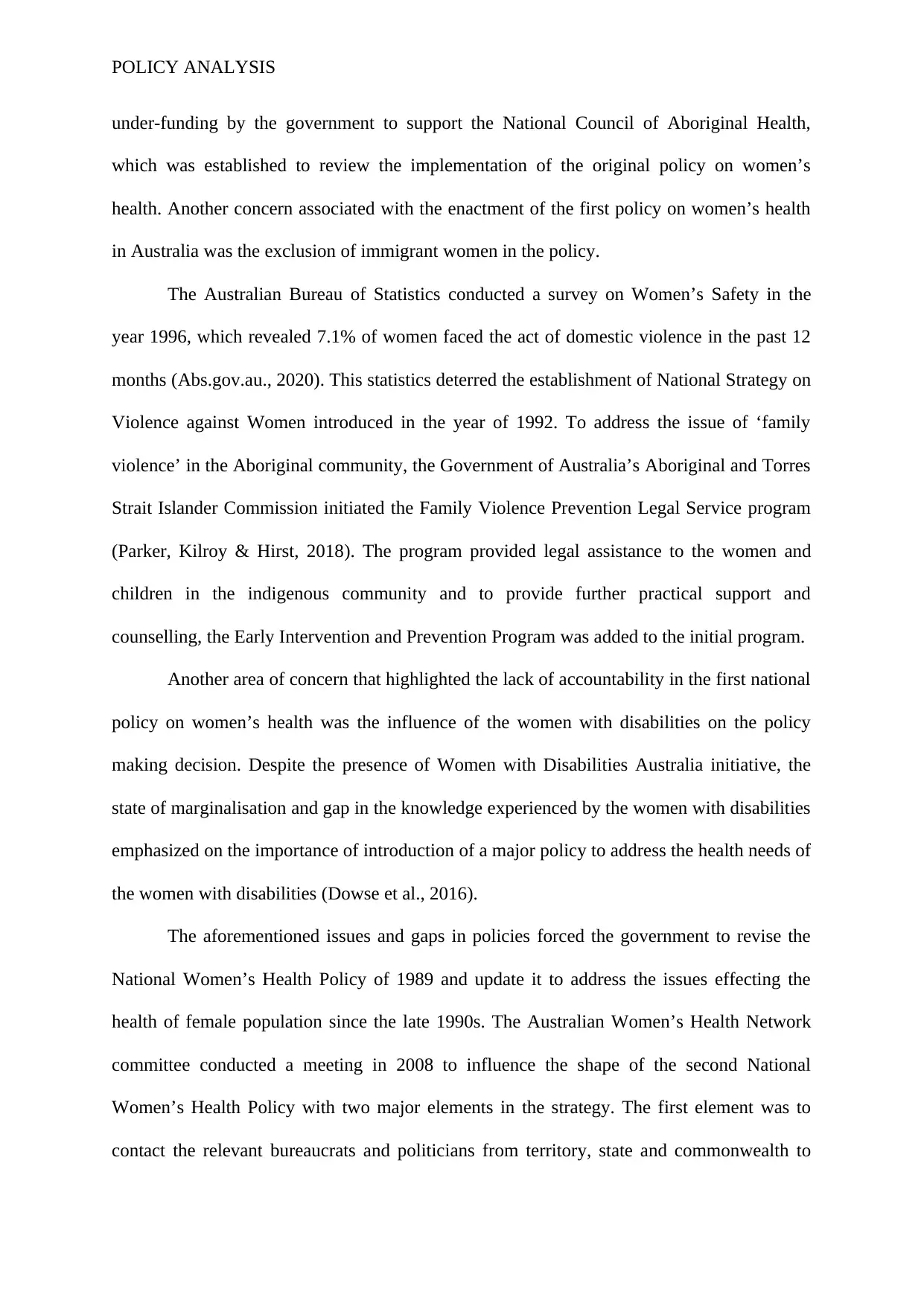
POLICY ANALYSIS
under-funding by the government to support the National Council of Aboriginal Health,
which was established to review the implementation of the original policy on women’s
health. Another concern associated with the enactment of the first policy on women’s health
in Australia was the exclusion of immigrant women in the policy.
The Australian Bureau of Statistics conducted a survey on Women’s Safety in the
year 1996, which revealed 7.1% of women faced the act of domestic violence in the past 12
months (Abs.gov.au., 2020). This statistics deterred the establishment of National Strategy on
Violence against Women introduced in the year of 1992. To address the issue of ‘family
violence’ in the Aboriginal community, the Government of Australia’s Aboriginal and Torres
Strait Islander Commission initiated the Family Violence Prevention Legal Service program
(Parker, Kilroy & Hirst, 2018). The program provided legal assistance to the women and
children in the indigenous community and to provide further practical support and
counselling, the Early Intervention and Prevention Program was added to the initial program.
Another area of concern that highlighted the lack of accountability in the first national
policy on women’s health was the influence of the women with disabilities on the policy
making decision. Despite the presence of Women with Disabilities Australia initiative, the
state of marginalisation and gap in the knowledge experienced by the women with disabilities
emphasized on the importance of introduction of a major policy to address the health needs of
the women with disabilities (Dowse et al., 2016).
The aforementioned issues and gaps in policies forced the government to revise the
National Women’s Health Policy of 1989 and update it to address the issues effecting the
health of female population since the late 1990s. The Australian Women’s Health Network
committee conducted a meeting in 2008 to influence the shape of the second National
Women’s Health Policy with two major elements in the strategy. The first element was to
contact the relevant bureaucrats and politicians from territory, state and commonwealth to
under-funding by the government to support the National Council of Aboriginal Health,
which was established to review the implementation of the original policy on women’s
health. Another concern associated with the enactment of the first policy on women’s health
in Australia was the exclusion of immigrant women in the policy.
The Australian Bureau of Statistics conducted a survey on Women’s Safety in the
year 1996, which revealed 7.1% of women faced the act of domestic violence in the past 12
months (Abs.gov.au., 2020). This statistics deterred the establishment of National Strategy on
Violence against Women introduced in the year of 1992. To address the issue of ‘family
violence’ in the Aboriginal community, the Government of Australia’s Aboriginal and Torres
Strait Islander Commission initiated the Family Violence Prevention Legal Service program
(Parker, Kilroy & Hirst, 2018). The program provided legal assistance to the women and
children in the indigenous community and to provide further practical support and
counselling, the Early Intervention and Prevention Program was added to the initial program.
Another area of concern that highlighted the lack of accountability in the first national
policy on women’s health was the influence of the women with disabilities on the policy
making decision. Despite the presence of Women with Disabilities Australia initiative, the
state of marginalisation and gap in the knowledge experienced by the women with disabilities
emphasized on the importance of introduction of a major policy to address the health needs of
the women with disabilities (Dowse et al., 2016).
The aforementioned issues and gaps in policies forced the government to revise the
National Women’s Health Policy of 1989 and update it to address the issues effecting the
health of female population since the late 1990s. The Australian Women’s Health Network
committee conducted a meeting in 2008 to influence the shape of the second National
Women’s Health Policy with two major elements in the strategy. The first element was to
contact the relevant bureaucrats and politicians from territory, state and commonwealth to
Paraphrase This Document
Need a fresh take? Get an instant paraphrase of this document with our AI Paraphraser
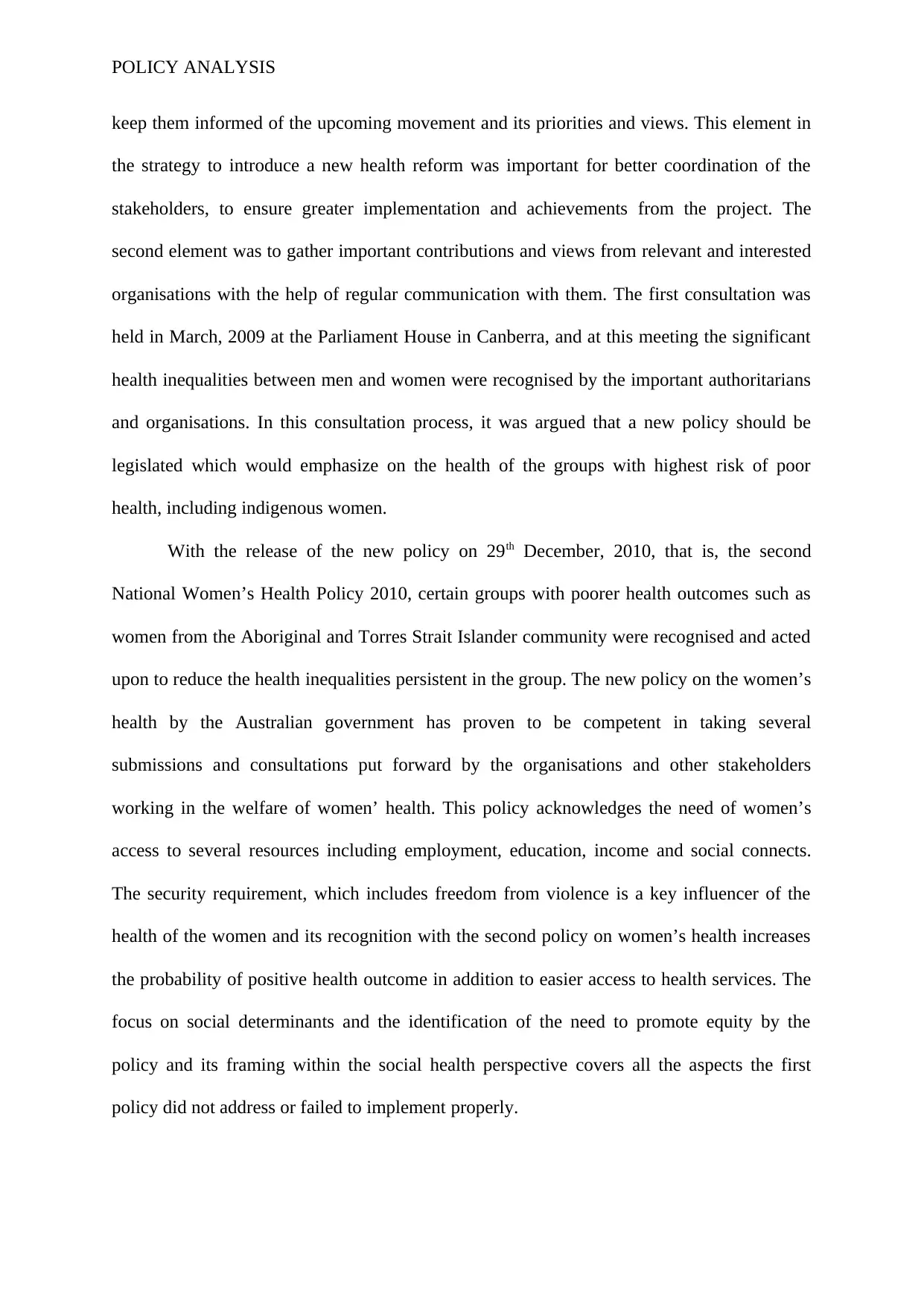
POLICY ANALYSIS
keep them informed of the upcoming movement and its priorities and views. This element in
the strategy to introduce a new health reform was important for better coordination of the
stakeholders, to ensure greater implementation and achievements from the project. The
second element was to gather important contributions and views from relevant and interested
organisations with the help of regular communication with them. The first consultation was
held in March, 2009 at the Parliament House in Canberra, and at this meeting the significant
health inequalities between men and women were recognised by the important authoritarians
and organisations. In this consultation process, it was argued that a new policy should be
legislated which would emphasize on the health of the groups with highest risk of poor
health, including indigenous women.
With the release of the new policy on 29th December, 2010, that is, the second
National Women’s Health Policy 2010, certain groups with poorer health outcomes such as
women from the Aboriginal and Torres Strait Islander community were recognised and acted
upon to reduce the health inequalities persistent in the group. The new policy on the women’s
health by the Australian government has proven to be competent in taking several
submissions and consultations put forward by the organisations and other stakeholders
working in the welfare of women’ health. This policy acknowledges the need of women’s
access to several resources including employment, education, income and social connects.
The security requirement, which includes freedom from violence is a key influencer of the
health of the women and its recognition with the second policy on women’s health increases
the probability of positive health outcome in addition to easier access to health services. The
focus on social determinants and the identification of the need to promote equity by the
policy and its framing within the social health perspective covers all the aspects the first
policy did not address or failed to implement properly.
keep them informed of the upcoming movement and its priorities and views. This element in
the strategy to introduce a new health reform was important for better coordination of the
stakeholders, to ensure greater implementation and achievements from the project. The
second element was to gather important contributions and views from relevant and interested
organisations with the help of regular communication with them. The first consultation was
held in March, 2009 at the Parliament House in Canberra, and at this meeting the significant
health inequalities between men and women were recognised by the important authoritarians
and organisations. In this consultation process, it was argued that a new policy should be
legislated which would emphasize on the health of the groups with highest risk of poor
health, including indigenous women.
With the release of the new policy on 29th December, 2010, that is, the second
National Women’s Health Policy 2010, certain groups with poorer health outcomes such as
women from the Aboriginal and Torres Strait Islander community were recognised and acted
upon to reduce the health inequalities persistent in the group. The new policy on the women’s
health by the Australian government has proven to be competent in taking several
submissions and consultations put forward by the organisations and other stakeholders
working in the welfare of women’ health. This policy acknowledges the need of women’s
access to several resources including employment, education, income and social connects.
The security requirement, which includes freedom from violence is a key influencer of the
health of the women and its recognition with the second policy on women’s health increases
the probability of positive health outcome in addition to easier access to health services. The
focus on social determinants and the identification of the need to promote equity by the
policy and its framing within the social health perspective covers all the aspects the first
policy did not address or failed to implement properly.
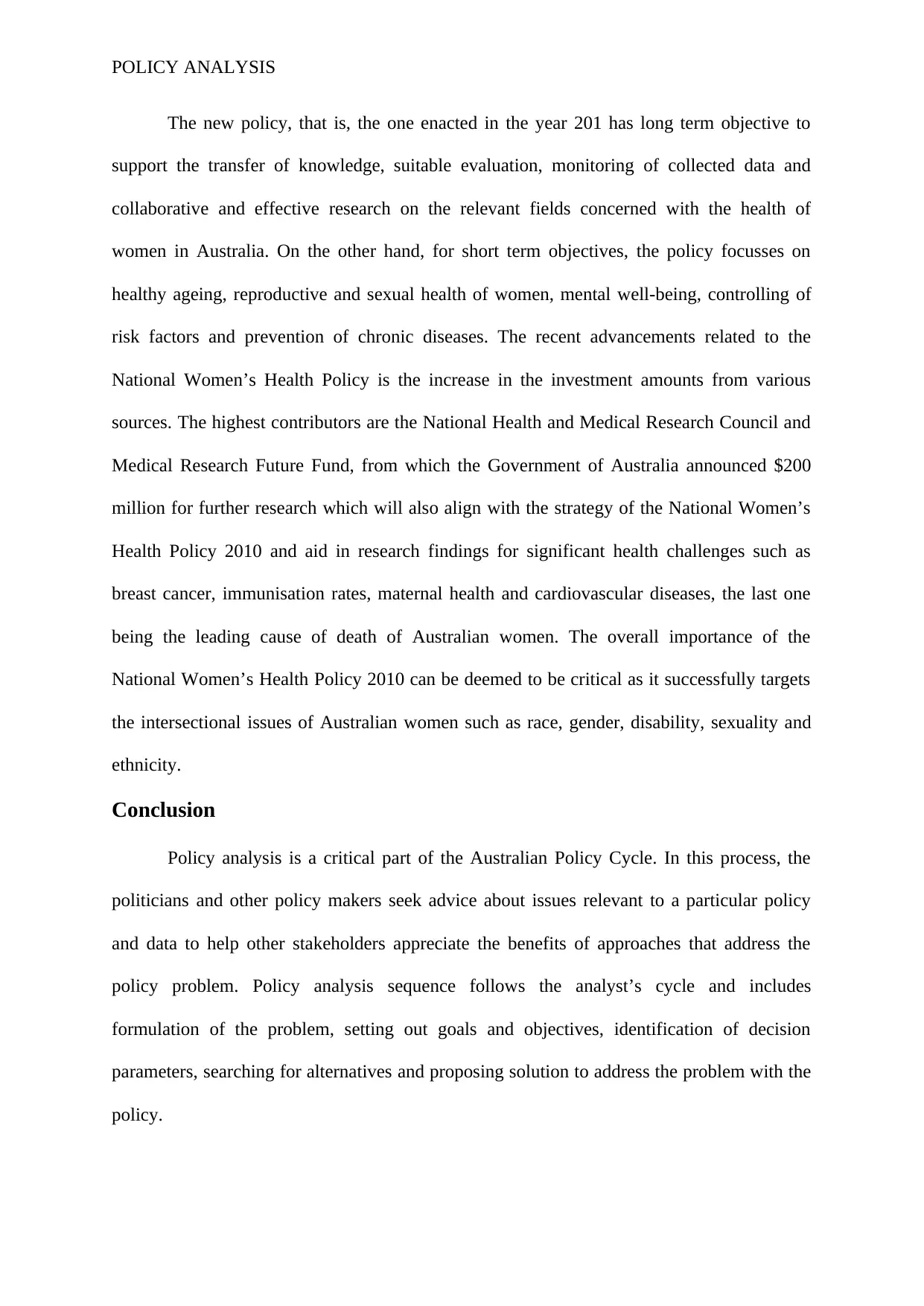
POLICY ANALYSIS
The new policy, that is, the one enacted in the year 201 has long term objective to
support the transfer of knowledge, suitable evaluation, monitoring of collected data and
collaborative and effective research on the relevant fields concerned with the health of
women in Australia. On the other hand, for short term objectives, the policy focusses on
healthy ageing, reproductive and sexual health of women, mental well-being, controlling of
risk factors and prevention of chronic diseases. The recent advancements related to the
National Women’s Health Policy is the increase in the investment amounts from various
sources. The highest contributors are the National Health and Medical Research Council and
Medical Research Future Fund, from which the Government of Australia announced $200
million for further research which will also align with the strategy of the National Women’s
Health Policy 2010 and aid in research findings for significant health challenges such as
breast cancer, immunisation rates, maternal health and cardiovascular diseases, the last one
being the leading cause of death of Australian women. The overall importance of the
National Women’s Health Policy 2010 can be deemed to be critical as it successfully targets
the intersectional issues of Australian women such as race, gender, disability, sexuality and
ethnicity.
Conclusion
Policy analysis is a critical part of the Australian Policy Cycle. In this process, the
politicians and other policy makers seek advice about issues relevant to a particular policy
and data to help other stakeholders appreciate the benefits of approaches that address the
policy problem. Policy analysis sequence follows the analyst’s cycle and includes
formulation of the problem, setting out goals and objectives, identification of decision
parameters, searching for alternatives and proposing solution to address the problem with the
policy.
The new policy, that is, the one enacted in the year 201 has long term objective to
support the transfer of knowledge, suitable evaluation, monitoring of collected data and
collaborative and effective research on the relevant fields concerned with the health of
women in Australia. On the other hand, for short term objectives, the policy focusses on
healthy ageing, reproductive and sexual health of women, mental well-being, controlling of
risk factors and prevention of chronic diseases. The recent advancements related to the
National Women’s Health Policy is the increase in the investment amounts from various
sources. The highest contributors are the National Health and Medical Research Council and
Medical Research Future Fund, from which the Government of Australia announced $200
million for further research which will also align with the strategy of the National Women’s
Health Policy 2010 and aid in research findings for significant health challenges such as
breast cancer, immunisation rates, maternal health and cardiovascular diseases, the last one
being the leading cause of death of Australian women. The overall importance of the
National Women’s Health Policy 2010 can be deemed to be critical as it successfully targets
the intersectional issues of Australian women such as race, gender, disability, sexuality and
ethnicity.
Conclusion
Policy analysis is a critical part of the Australian Policy Cycle. In this process, the
politicians and other policy makers seek advice about issues relevant to a particular policy
and data to help other stakeholders appreciate the benefits of approaches that address the
policy problem. Policy analysis sequence follows the analyst’s cycle and includes
formulation of the problem, setting out goals and objectives, identification of decision
parameters, searching for alternatives and proposing solution to address the problem with the
policy.
⊘ This is a preview!⊘
Do you want full access?
Subscribe today to unlock all pages.

Trusted by 1+ million students worldwide
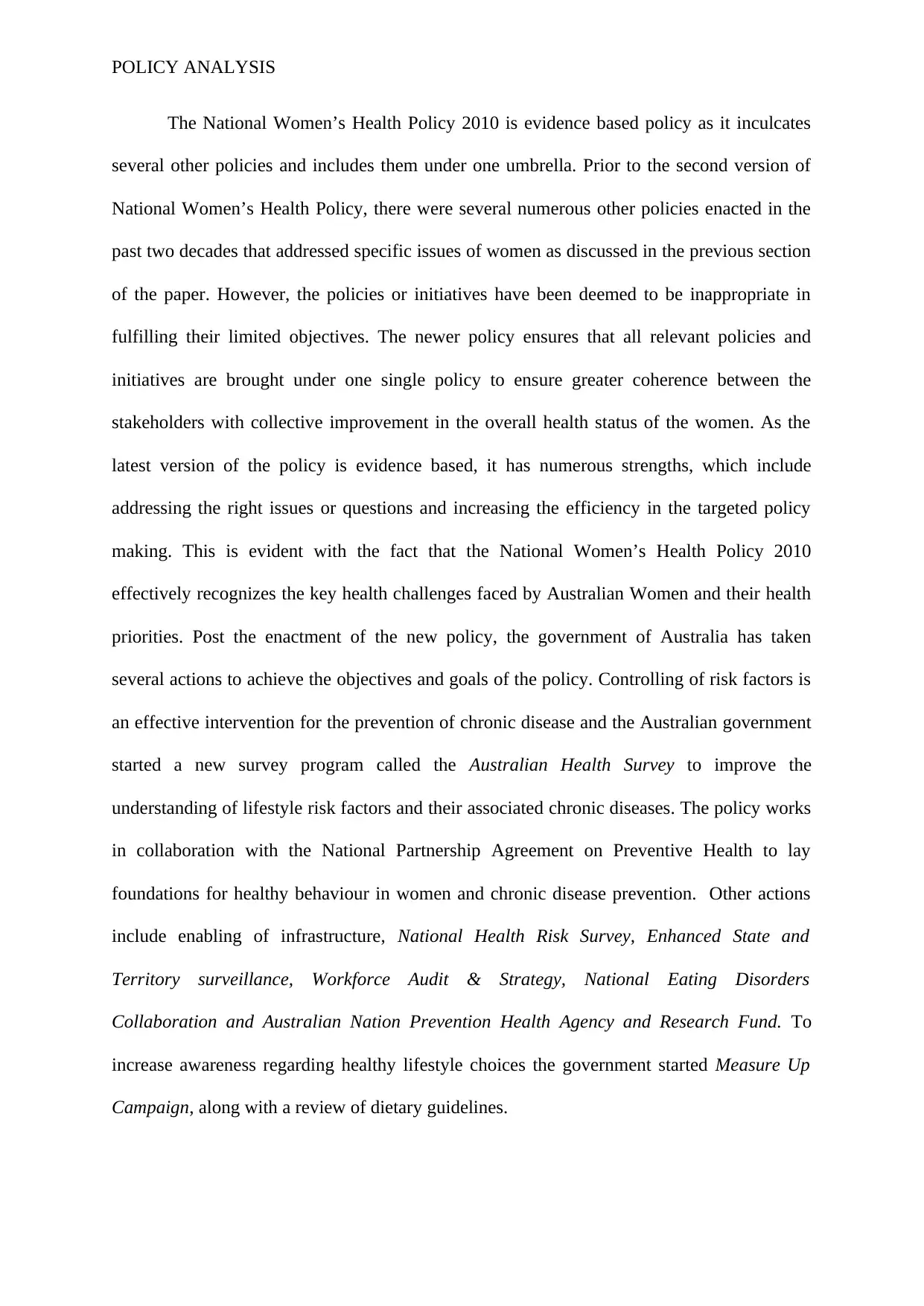
POLICY ANALYSIS
The National Women’s Health Policy 2010 is evidence based policy as it inculcates
several other policies and includes them under one umbrella. Prior to the second version of
National Women’s Health Policy, there were several numerous other policies enacted in the
past two decades that addressed specific issues of women as discussed in the previous section
of the paper. However, the policies or initiatives have been deemed to be inappropriate in
fulfilling their limited objectives. The newer policy ensures that all relevant policies and
initiatives are brought under one single policy to ensure greater coherence between the
stakeholders with collective improvement in the overall health status of the women. As the
latest version of the policy is evidence based, it has numerous strengths, which include
addressing the right issues or questions and increasing the efficiency in the targeted policy
making. This is evident with the fact that the National Women’s Health Policy 2010
effectively recognizes the key health challenges faced by Australian Women and their health
priorities. Post the enactment of the new policy, the government of Australia has taken
several actions to achieve the objectives and goals of the policy. Controlling of risk factors is
an effective intervention for the prevention of chronic disease and the Australian government
started a new survey program called the Australian Health Survey to improve the
understanding of lifestyle risk factors and their associated chronic diseases. The policy works
in collaboration with the National Partnership Agreement on Preventive Health to lay
foundations for healthy behaviour in women and chronic disease prevention. Other actions
include enabling of infrastructure, National Health Risk Survey, Enhanced State and
Territory surveillance, Workforce Audit & Strategy, National Eating Disorders
Collaboration and Australian Nation Prevention Health Agency and Research Fund. To
increase awareness regarding healthy lifestyle choices the government started Measure Up
Campaign, along with a review of dietary guidelines.
The National Women’s Health Policy 2010 is evidence based policy as it inculcates
several other policies and includes them under one umbrella. Prior to the second version of
National Women’s Health Policy, there were several numerous other policies enacted in the
past two decades that addressed specific issues of women as discussed in the previous section
of the paper. However, the policies or initiatives have been deemed to be inappropriate in
fulfilling their limited objectives. The newer policy ensures that all relevant policies and
initiatives are brought under one single policy to ensure greater coherence between the
stakeholders with collective improvement in the overall health status of the women. As the
latest version of the policy is evidence based, it has numerous strengths, which include
addressing the right issues or questions and increasing the efficiency in the targeted policy
making. This is evident with the fact that the National Women’s Health Policy 2010
effectively recognizes the key health challenges faced by Australian Women and their health
priorities. Post the enactment of the new policy, the government of Australia has taken
several actions to achieve the objectives and goals of the policy. Controlling of risk factors is
an effective intervention for the prevention of chronic disease and the Australian government
started a new survey program called the Australian Health Survey to improve the
understanding of lifestyle risk factors and their associated chronic diseases. The policy works
in collaboration with the National Partnership Agreement on Preventive Health to lay
foundations for healthy behaviour in women and chronic disease prevention. Other actions
include enabling of infrastructure, National Health Risk Survey, Enhanced State and
Territory surveillance, Workforce Audit & Strategy, National Eating Disorders
Collaboration and Australian Nation Prevention Health Agency and Research Fund. To
increase awareness regarding healthy lifestyle choices the government started Measure Up
Campaign, along with a review of dietary guidelines.
Paraphrase This Document
Need a fresh take? Get an instant paraphrase of this document with our AI Paraphraser
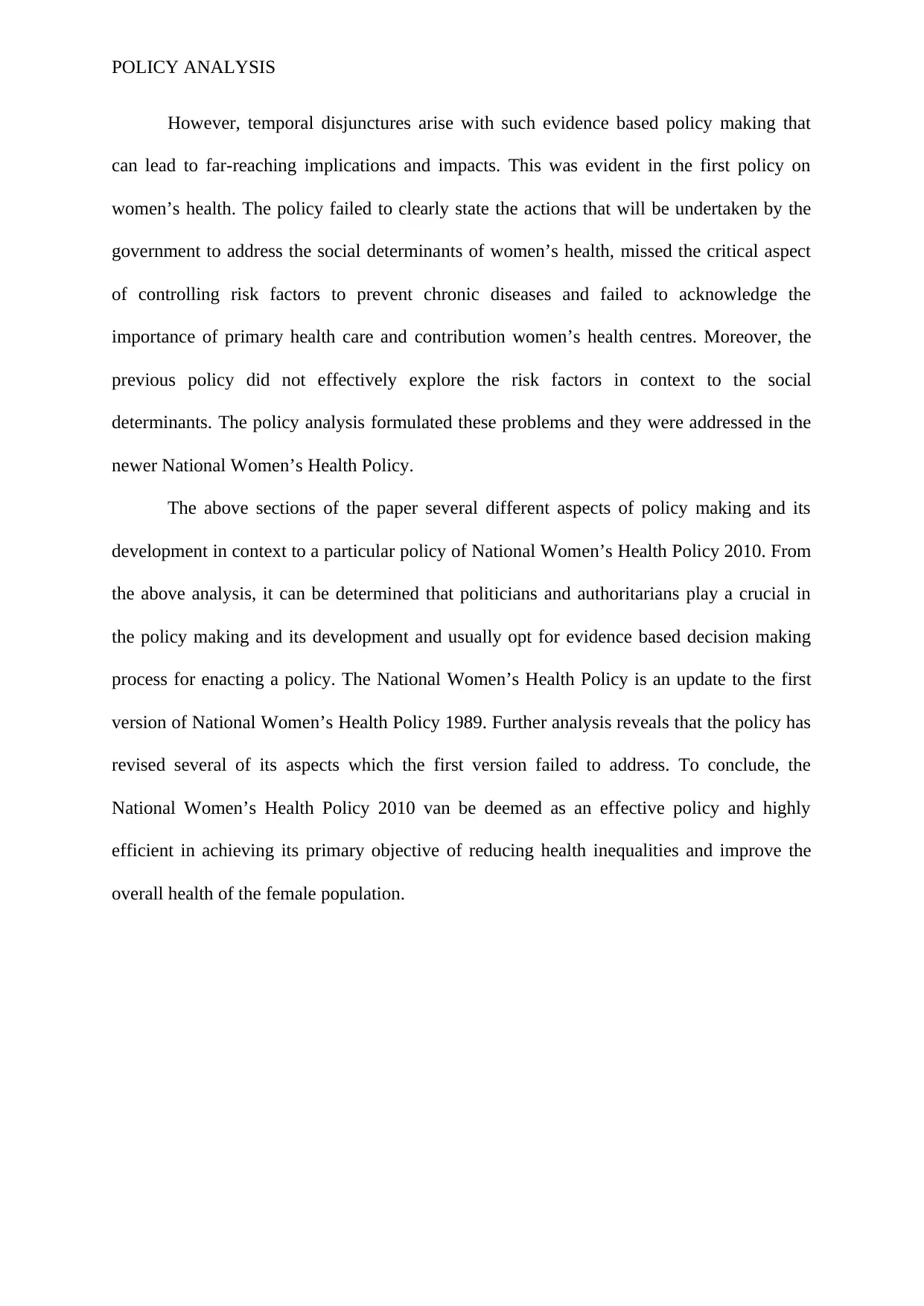
POLICY ANALYSIS
However, temporal disjunctures arise with such evidence based policy making that
can lead to far-reaching implications and impacts. This was evident in the first policy on
women’s health. The policy failed to clearly state the actions that will be undertaken by the
government to address the social determinants of women’s health, missed the critical aspect
of controlling risk factors to prevent chronic diseases and failed to acknowledge the
importance of primary health care and contribution women’s health centres. Moreover, the
previous policy did not effectively explore the risk factors in context to the social
determinants. The policy analysis formulated these problems and they were addressed in the
newer National Women’s Health Policy.
The above sections of the paper several different aspects of policy making and its
development in context to a particular policy of National Women’s Health Policy 2010. From
the above analysis, it can be determined that politicians and authoritarians play a crucial in
the policy making and its development and usually opt for evidence based decision making
process for enacting a policy. The National Women’s Health Policy is an update to the first
version of National Women’s Health Policy 1989. Further analysis reveals that the policy has
revised several of its aspects which the first version failed to address. To conclude, the
National Women’s Health Policy 2010 van be deemed as an effective policy and highly
efficient in achieving its primary objective of reducing health inequalities and improve the
overall health of the female population.
However, temporal disjunctures arise with such evidence based policy making that
can lead to far-reaching implications and impacts. This was evident in the first policy on
women’s health. The policy failed to clearly state the actions that will be undertaken by the
government to address the social determinants of women’s health, missed the critical aspect
of controlling risk factors to prevent chronic diseases and failed to acknowledge the
importance of primary health care and contribution women’s health centres. Moreover, the
previous policy did not effectively explore the risk factors in context to the social
determinants. The policy analysis formulated these problems and they were addressed in the
newer National Women’s Health Policy.
The above sections of the paper several different aspects of policy making and its
development in context to a particular policy of National Women’s Health Policy 2010. From
the above analysis, it can be determined that politicians and authoritarians play a crucial in
the policy making and its development and usually opt for evidence based decision making
process for enacting a policy. The National Women’s Health Policy is an update to the first
version of National Women’s Health Policy 1989. Further analysis reveals that the policy has
revised several of its aspects which the first version failed to address. To conclude, the
National Women’s Health Policy 2010 van be deemed as an effective policy and highly
efficient in achieving its primary objective of reducing health inequalities and improve the
overall health of the female population.
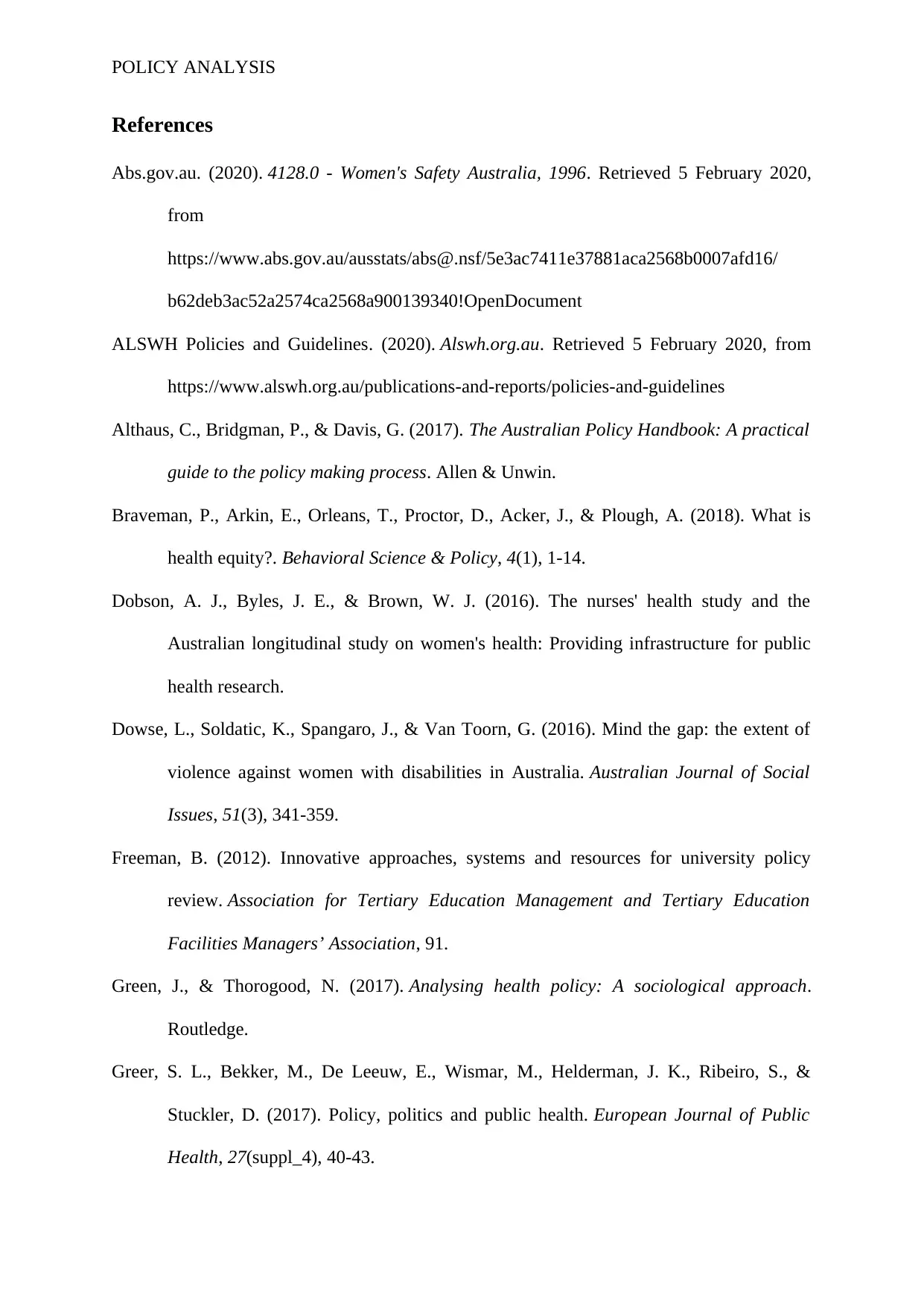
POLICY ANALYSIS
References
Abs.gov.au. (2020). 4128.0 - Women's Safety Australia, 1996. Retrieved 5 February 2020,
from
https://www.abs.gov.au/ausstats/abs@.nsf/5e3ac7411e37881aca2568b0007afd16/
b62deb3ac52a2574ca2568a900139340!OpenDocument
ALSWH Policies and Guidelines. (2020). Alswh.org.au. Retrieved 5 February 2020, from
https://www.alswh.org.au/publications-and-reports/policies-and-guidelines
Althaus, C., Bridgman, P., & Davis, G. (2017). The Australian Policy Handbook: A practical
guide to the policy making process. Allen & Unwin.
Braveman, P., Arkin, E., Orleans, T., Proctor, D., Acker, J., & Plough, A. (2018). What is
health equity?. Behavioral Science & Policy, 4(1), 1-14.
Dobson, A. J., Byles, J. E., & Brown, W. J. (2016). The nurses' health study and the
Australian longitudinal study on women's health: Providing infrastructure for public
health research.
Dowse, L., Soldatic, K., Spangaro, J., & Van Toorn, G. (2016). Mind the gap: the extent of
violence against women with disabilities in Australia. Australian Journal of Social
Issues, 51(3), 341-359.
Freeman, B. (2012). Innovative approaches, systems and resources for university policy
review. Association for Tertiary Education Management and Tertiary Education
Facilities Managers’ Association, 91.
Green, J., & Thorogood, N. (2017). Analysing health policy: A sociological approach.
Routledge.
Greer, S. L., Bekker, M., De Leeuw, E., Wismar, M., Helderman, J. K., Ribeiro, S., &
Stuckler, D. (2017). Policy, politics and public health. European Journal of Public
Health, 27(suppl_4), 40-43.
References
Abs.gov.au. (2020). 4128.0 - Women's Safety Australia, 1996. Retrieved 5 February 2020,
from
https://www.abs.gov.au/ausstats/abs@.nsf/5e3ac7411e37881aca2568b0007afd16/
b62deb3ac52a2574ca2568a900139340!OpenDocument
ALSWH Policies and Guidelines. (2020). Alswh.org.au. Retrieved 5 February 2020, from
https://www.alswh.org.au/publications-and-reports/policies-and-guidelines
Althaus, C., Bridgman, P., & Davis, G. (2017). The Australian Policy Handbook: A practical
guide to the policy making process. Allen & Unwin.
Braveman, P., Arkin, E., Orleans, T., Proctor, D., Acker, J., & Plough, A. (2018). What is
health equity?. Behavioral Science & Policy, 4(1), 1-14.
Dobson, A. J., Byles, J. E., & Brown, W. J. (2016). The nurses' health study and the
Australian longitudinal study on women's health: Providing infrastructure for public
health research.
Dowse, L., Soldatic, K., Spangaro, J., & Van Toorn, G. (2016). Mind the gap: the extent of
violence against women with disabilities in Australia. Australian Journal of Social
Issues, 51(3), 341-359.
Freeman, B. (2012). Innovative approaches, systems and resources for university policy
review. Association for Tertiary Education Management and Tertiary Education
Facilities Managers’ Association, 91.
Green, J., & Thorogood, N. (2017). Analysing health policy: A sociological approach.
Routledge.
Greer, S. L., Bekker, M., De Leeuw, E., Wismar, M., Helderman, J. K., Ribeiro, S., &
Stuckler, D. (2017). Policy, politics and public health. European Journal of Public
Health, 27(suppl_4), 40-43.
⊘ This is a preview!⊘
Do you want full access?
Subscribe today to unlock all pages.

Trusted by 1+ million students worldwide
1 out of 13
Related Documents
Your All-in-One AI-Powered Toolkit for Academic Success.
+13062052269
info@desklib.com
Available 24*7 on WhatsApp / Email
![[object Object]](/_next/static/media/star-bottom.7253800d.svg)
Unlock your academic potential
Copyright © 2020–2025 A2Z Services. All Rights Reserved. Developed and managed by ZUCOL.





